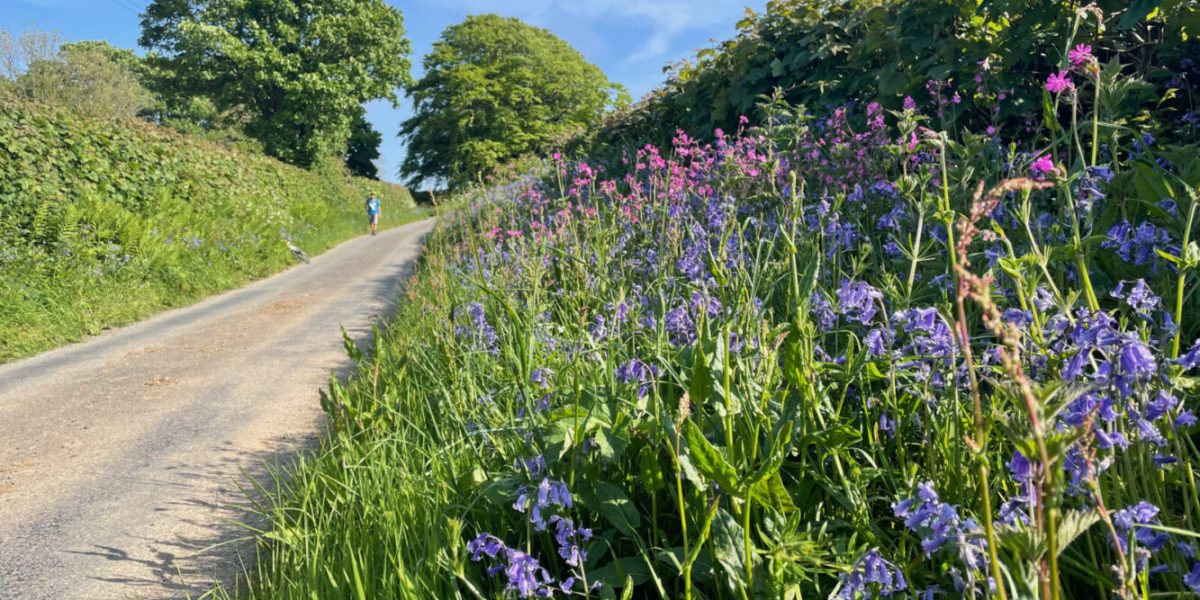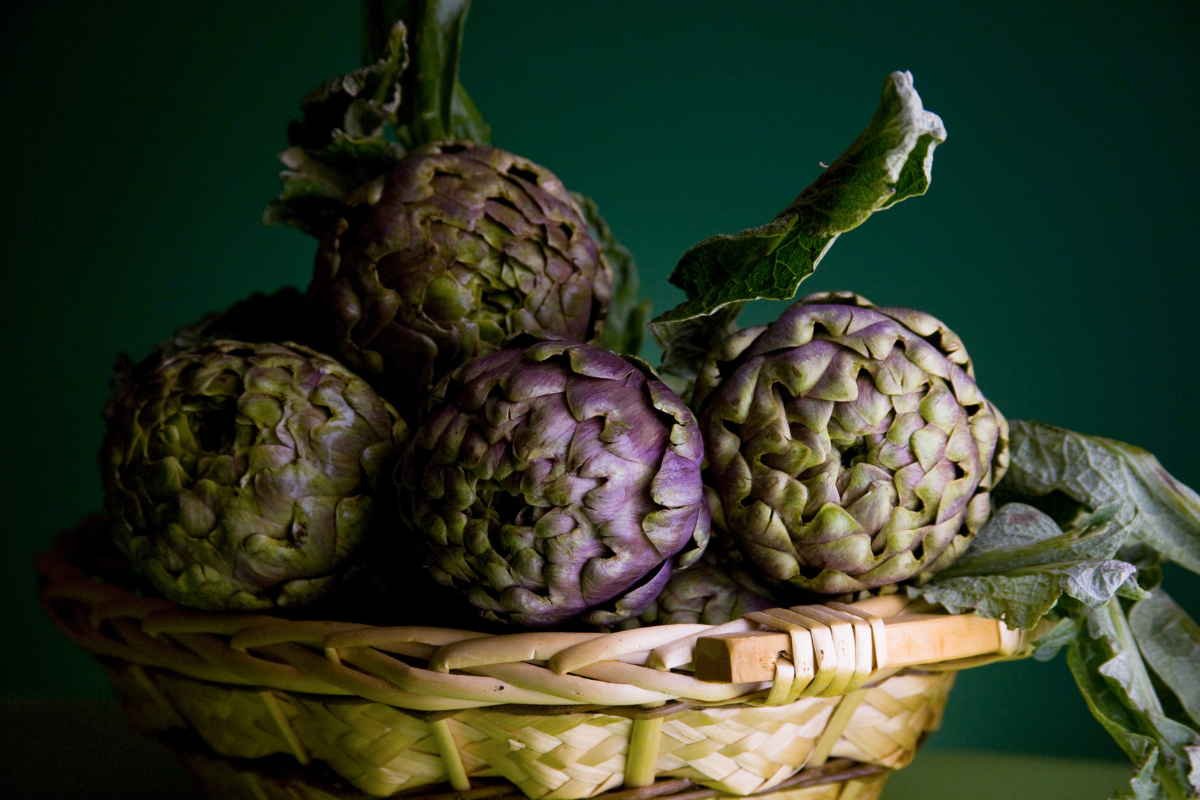In this article, Lizzy from Railholiday takes a look at Hedgerow Wildflowers, creating a seasonal guide to the native blooms we can all enjoy on a sunny ramble through the countryside. After all, it’s that time of year when the hedges are abundant with beautiful flowers. Lizzy recommends that the best way to enjoy the bounty is to take a walk along the many tiny country lanes and footpaths. You may be familiar with many of these flowers, but hopefully, this short guide will help you name ones you don’t know. It is far from comprehensive, but there are many excellent field guides to extend your knowledge. Lizzy recommends Marjorie Blamey’s Wild Flowers by Colour, which can be ordered from your local bookshop.
Guests at Railholiday in St Germans may like to take a stroll through ten acres of woodland; you should be able to see many of the flowers listed there. For coastal flowers, head to Portwrinkle and take a walk along the coast path towards Rame Head, or catch the ferry from Plymouth to Cremyll and explore the nature reserve at Maker.
Over to Lizzy, and we hope you enjoy this short film, and find the photos helpful.
Among the many wildflowers is a group called umbellifers. Umbellifers have an umbrella-like structure holding tiny flowers on the end of each spoke. There are several common umbellifers to look out for, some of which are highly poisonous.
Another group to look out for is members of the mint family, which includes the nettles. All flowers in this group have a square stem. Brassicas are another common family; their flowers usually have four petals. Nitrogen-fixing legumes include clover and vetch, while the members of the plantain family (no relative of the fruit) are very varied and include snapdragons and foxgloves.
White Flowers

Cow Parsley – this is a member of the umbellifer family. Cow parsley has finely laced leaves.
Hogweed comes a little later than cow parsley and has a thick stem, large flat serrated leaves and white flowers.
Water Hemlock – at its peak in June. Likes watery places and is very poisonous. It has large round white umbellifer flower heads. Also known as fool’s parsley, it was once a common cause of poisoning among country people. Usually, it has purplish-red colouration on the stems.
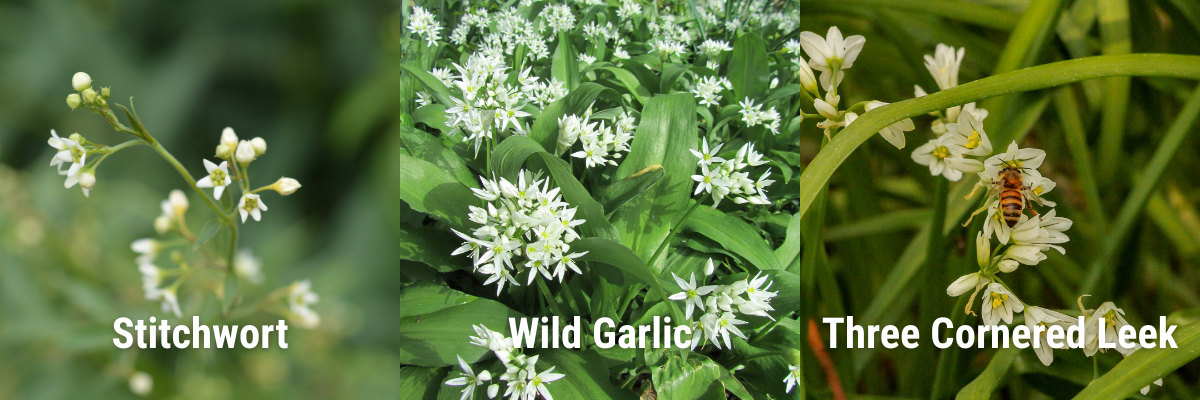
Stitchwort – white open flowers on delicate stems.
Wild Garlic, or Ransoms – a useful food plant, these pretty white clocks cloak the ground from April above wide leaves. This is not to be confused with Three Cornered Leek, which has thin leaves and bell-shaped flowers. Three-cornered leek is an invasive plant and should be pulled up and eaten at every opportunity.
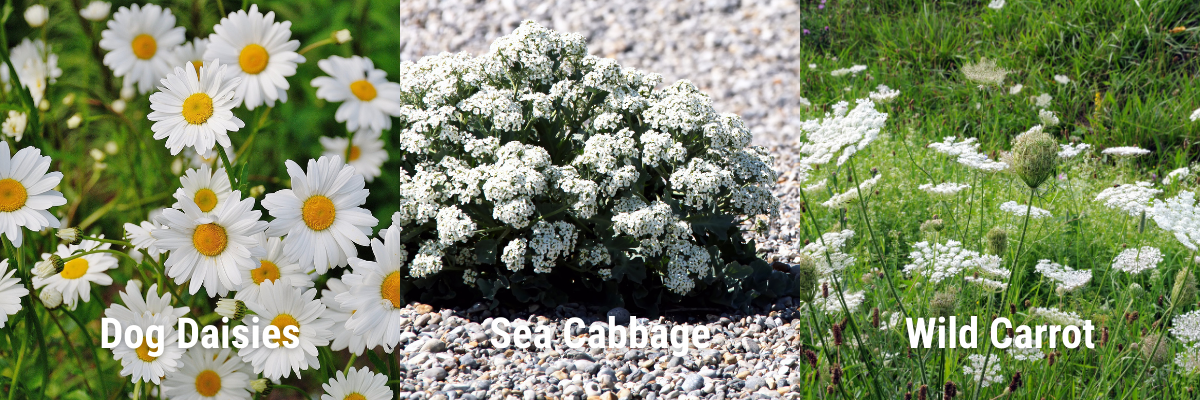
Dog Daisies – large daisies that quickly cover areas of waste ground.
Sea Cabbage – very distinctly of the brassica family, with white flowers and a distinctly cabbage smell.
Wild Carrot – an umbellifer commonly found in coastal areas. When pollinated its flower curves into a tight ball.
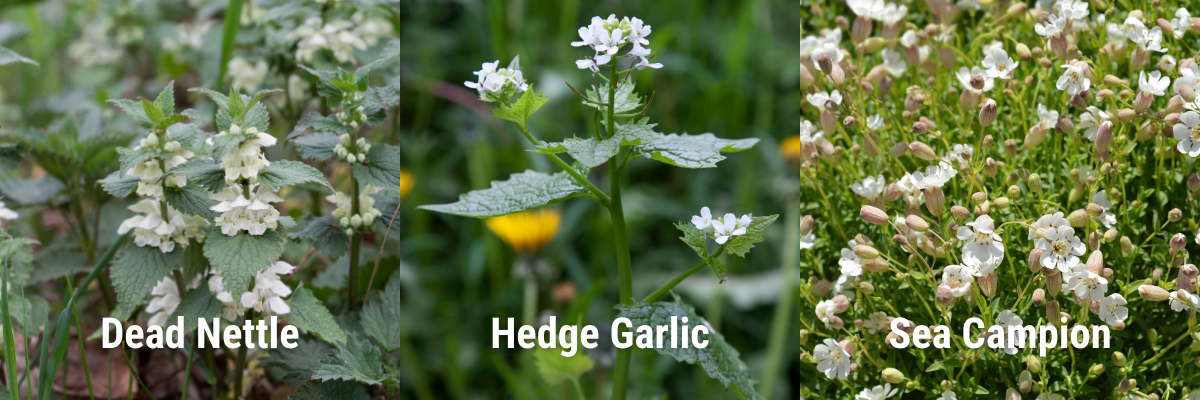
Dead Nettle – a nettle with no sting. Like stinging nettles, its leaves are slightly hairy. As a member of the mint family, it has a square stem.
Sea Campion – pretty white flowers on short stems on dense vegetation. Usually found beside cliff paths.
Hedge Garlic, Jack-by-the-hedge or Garlic Mustard – an upright plant with serrated leaves. This is a member of the cabbage family and has tasty mustard-flavoured leaves that I like to use in salads.
Yellow Flowers
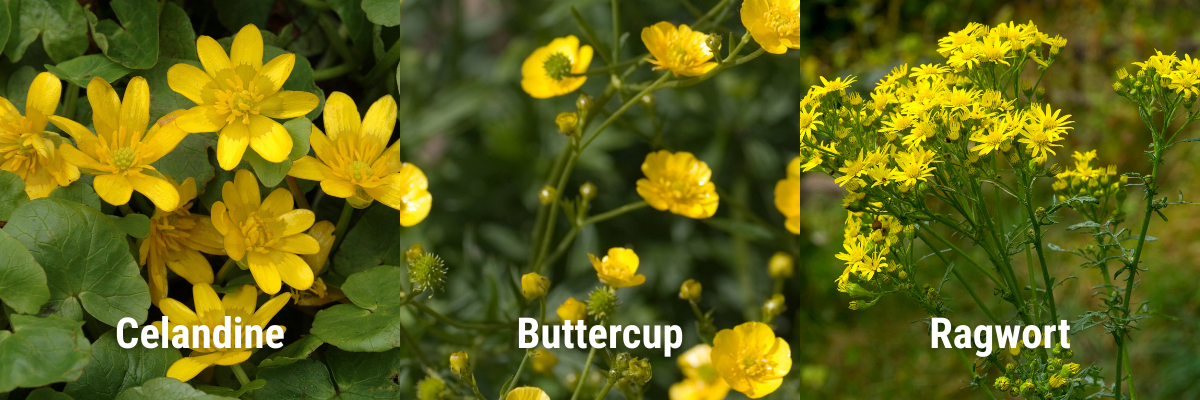
Celandine – the same glossy yellow as buttercup, but Celandine flowers much earlier and has thinner petals and deep green heart-shaped leaves.
Buttercup – There are two types of buttercup, one creeping with dark green serrated leaves, and one much taller that is commonly found in fields.
Ragwort – the food source of the cinnabar moth, ragwort is a valuable pollinator plant that flowers from June. Ragwort has bad press because it is poisonous to horses and cows. However, this is only a problem once the plant has been cut and either found its way into hay or been left cut in a hedgerow. When it is alive and growing in hedges or fields animals will avoid it.
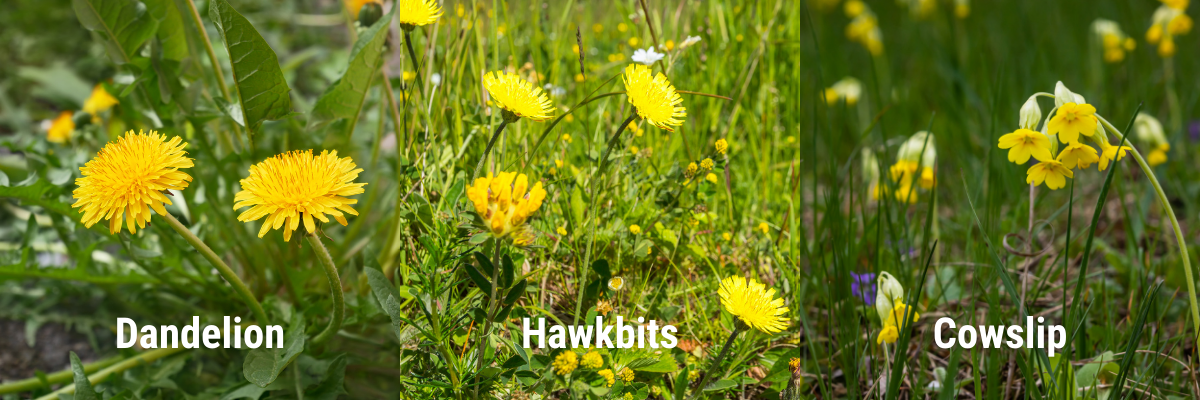
Dandelion – this needs no introduction, other than to say dandelion leaves are very nutritious, though they can be rather bitter. In a foraging life they might be considered a superhero, rather than a pernicious weed. And the pollinators love them.
Hawkbits – dandelion-type flowers on tall stems, much loved by pollinators. There are so many types that without a detailed flower guide it is difficult to tell them apart, so I tend to clump them all under the same name.
Cowslip – relatively uncommon in Cornwall, this field flower is a member of the primula family and holds clusters of small yellow flowers on a sturdy stem.
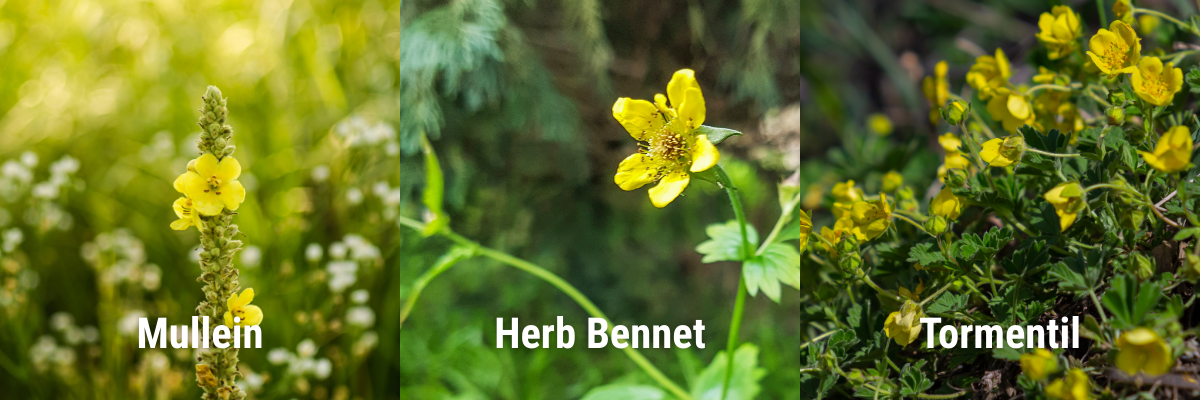
Mullein – quite foxglove-like in its presentation, mullein throws up tall yellow flower spikes above a rosette of velvety grey leaves.
Herb Bennet, or wood avens – this small yellow flower is a wild geum and self-seeds freely in semi-shaded places.
Tormentil – usually found on moorland, this tiny yellow flower has four petals.
Green Flowers

Navelwort, or pennywort – this fleshy succulent tastes like cucumber. Its name is inspired by the dimple in the centre of the leaf, which looks like a tummy-button. In May it shoots up little pale green foxglove-like flowers.
Dog’s Mercury – A poisonous woodland plant, this perennial carpets the understory of shady places. In spring and early summer, it sends out racemes of tiny green flowers.
Alexanders – a common coastal plant. Alexanders were brought over by the Romans as a food plant and have leaves that are glossy green and yellow-green flowers that are very tasty in salads.
Pink, Purple and Red Flowers
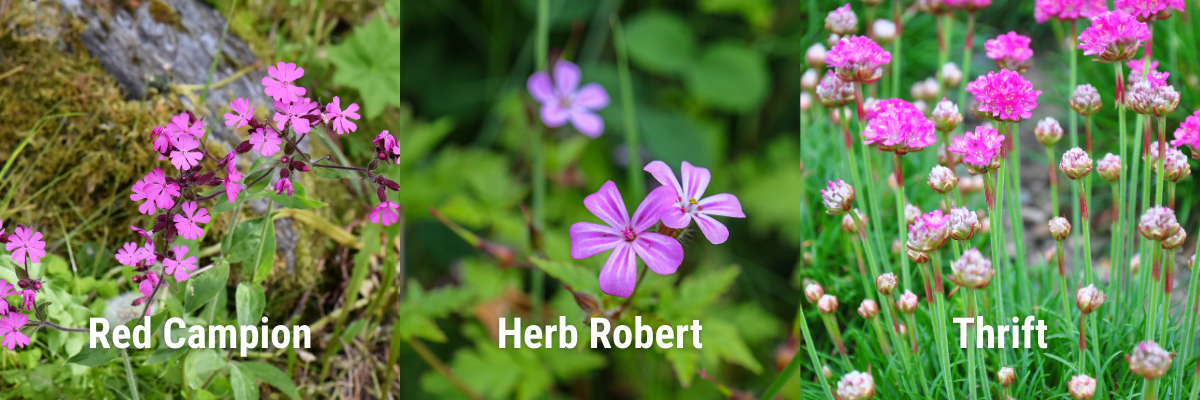
Red campion – pretty cerise-coloured flowers that will often be in bloom from March until November. They are at their peak at the moment. You may also come across the occasional white campion.
Herb Robert – a wild geranium and a common weed often found in flowerbeds, it smells very distinctive when pulled up by its shallow roots.
Thrift – a cliff flower – pretty pink pompoms in dense clusters.
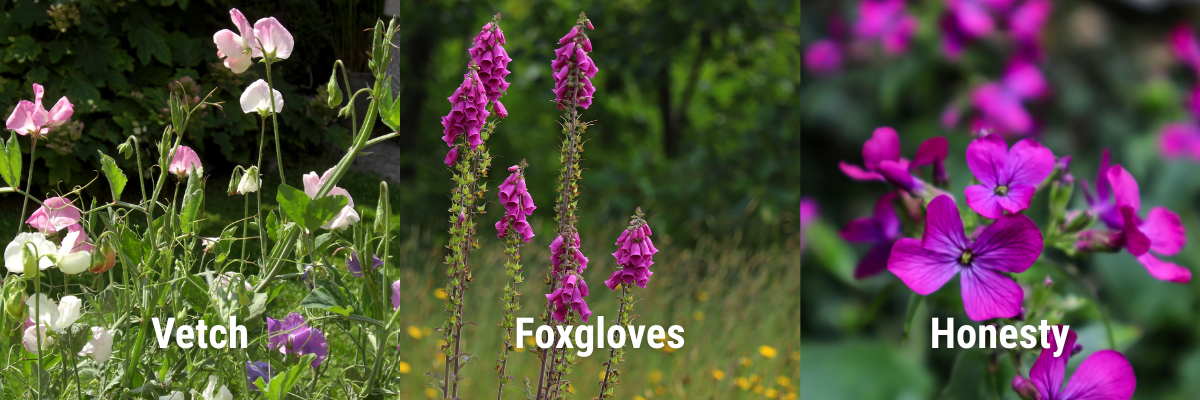
Vetch – this purple scrambling flower of the pea family can be found in hedges and grasslands and is distinctive by its curling tendrils and leaves that are like folded ovals and sit opposite each other. Later it sets black seed pods. There are around 240 variants of vetches, including some with small pink flowers. Like other members of the legume family, it is a useful nitrogen-fixing plant.
Foxgloves – tall purple-pink flowers, often in colonies. Foxglove seeds can survive for over a century in dormancy, waiting for the right conditions. We once made a track through our woods, and the following year it was absolutely covered in foxgloves, that had taken advantage of the increase in sunlight and the disturbed bare soil.
Honesty – heart-shaped leaves and beautiful purple flowers make way for shiny seed pod carcasses that look like shiny pennies in the autumn. Honesty, like Hedge Garlic, is a member of the cabbage family and has similar features, including four-petalled flowers and serrated-edge heart-shaped leaves.

Clover – another member of the legume family that is a valuable nitrogen fixer, clover can be seen in meadowland. It can be white or pink, and its sweet flowers are much loved by bees.
Mallow – large multi-stemmed plant, common on the coast, that can become a small bush with pink flowers much loved by bees.
Red, pink and white valerian – this grows freely in sunny Cornish and Devon hedgerows, particularly on dry walls, and is much loved by pollinators.
Blue Flowers

Bluebell – drooping racemes of indigo flowers on one side of the stem. These are different from the invasive cultivated Spanish bluebell, which is larger, more grey in colour, and has more open flowers that protrude from all sides of the stem.
Ivy Leaved Toadflax – found in walls, this tiny snapdragon is a member of the plantain family, that includes foxgloves and yellow toadflax, which is also found in hedgerows in the summer. It is unrelated to the fruit of the same name!
Green Alkanet – a borage-like indigo blue flower on a sturdy hairy-leaved and stemmed plant. Traditionally used in dyes, hence the name.
Brown Flowers
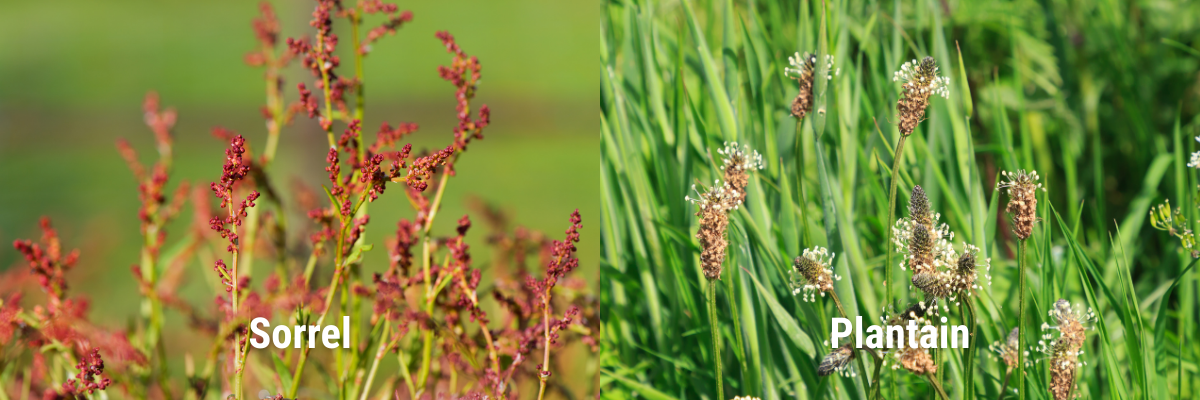
Sorrel – reddish brown thin racemes of flowers. More delicate than dock, which is the same family, sorrel’s leaves are useful in salad and have a sour lemony flavour.
Plantain – there are two common types, greater plantain, with thick wide leaves, and ribbed plantain with thinner ribbed leaves. Both are great for playing plantain conker fights with.
So, whether you’re wandering the winding lanes of Cornwall or exploring footpaths in Devon, the hedgerow wildflowers of the Tamar Valley offer a rich and ever-changing tapestry of colour and life. From delicate stitchwort and vibrant red campion to towering foxgloves and the quietly powerful ragwort, there’s always something new to spot.
We hope this seasonal guide helps you identify a few more of these native flowers on your countryside rambles. Don’t forget to bring a field guide—or simply take your time and enjoy the discovery. Happy walking, and may your path be lined with petals.
Best wishes and thanks for reading,
Lizzy

